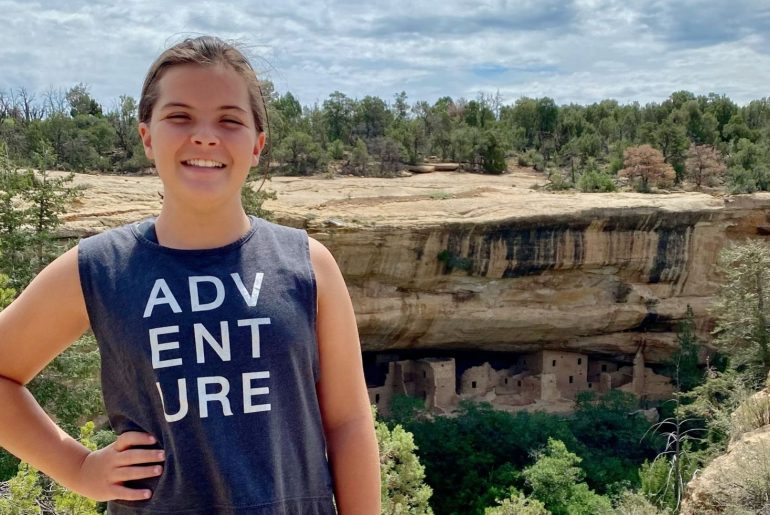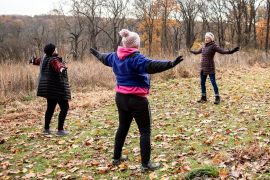This summer, we did something that was way outside our comfort zone. We packed up our three kids (ages 6, 8, and 12) into our Subaru and headed west for a 30 day adventure. During that time, we visited 15 states and several National Parks between Maryland and Wyoming! (You can also check out some of the places we visited on our Instagram Reels.)
So many families are thinking of opting outside for fall adventures this year… so if you’re new to National Park adventures, here are a few tips and tricks we learned along the way!
6 Tips for Planning Your National Parks Trip… with Kids!
Purchase an Annual National Park Pass
Yes, you can purchase an individual entrance pass for each National Park but you’ll save time (and most likely money!) if you purchase an Annual National Park Pass. A pass is your ticket to more than 2,000 federal recreation sites! Each pass covers entrance fees at national parks and national wildlife refuges as well as standard amenity fees (day use fees) at national forests and grasslands, and at lands managed by the Bureau of Land Management, Bureau of Reclamation and U.S. Army Corps of Engineers. Annual Passes are $80 for the whole family. Free military passes and $20 Annual Senior Passes are also available. Passes are available from any National Park or you can purchase them online.
Note: US 4th graders, including home-schooled and free-choice learners 10 years of age, can get into any National Park FREE with a valid Every Kid Outdoors paper pass!
Don’t Forget The “Old School” Map + Do Your Research
Beauty and wonder abound in National Parks. Great cell coverage and wifi? Not so much. Bring your cell phone with the handy All Trails App, but also be sure to grab a paper map from the Visitor’s Center. It will be super helpful when you don’t have service. It will also tell you which trails and sights are under maintenance so that you can plan your day. If you have littles, the maps will also quickly tell you which trails are stroller friendly (i.e. accessible), too! But honestly, strollers are tricky on most trails. If you want to see some ‘off the beaten path’ places, a backpack carrier is the way to go if you are bringing along young kids.
Even if you don’t think of yourself as a ‘planner,’ definitely do a little research on the park you’re visiting before you go. Sure, you could ‘fly by the seat of your pants,’ but imagine what you might miss! National Parks are HUGE. It’s hard to cover all of them in one day or even a few days. Check out the National Parks Service website before you go and see what areas of the park you want cover. Some of the sites may require advance registration or permits (Mesa Verde National Park required advance registration for a Cliff Dwelling Tour, for example). You don’t want to be disappointed when you get there! You can also download any self-guided audio tours before you go since wifi and connectivity might be a problem when you get to the park.

Scour Instagram — But Use General Geotagging
My favorite research tool for travel? Instagram! Just open the app on your phone and search recent posts by park location and locations nearby. This is a great way to find restaurants and other locations to visit on your park adventure. When you post your pics, make sure your using general geotags (i.e. the park name) and not specific geographic locations within the park. That helps keep the parks ‘wild’ and prevent heavy foot traffic to any one particular spot.
Pack The Essentials
Heading into a National Park isn’t quite like visiting your neighborhood trail — and to get the true park experience, you want to be able to do all the things! While you don’t need to buy out your local REI, here are a few things that we found came in handy:
- Backpack with Cooler Pocket: One bag with a cooler pocket is much easier to carry than trying to lug a backpack AND
- Zulu Ace Water Bottle*: Sure, Hydroflasks are cool but this water bottle has a removable bottom that makes it easier to clean and a sleeker shape so it fits in your car’s cupholder, too. Most National Parks have a water bottle refill station. Skip the plastic one-use ones!
- Waterproof Dry Bag*: This is a MUST if you plan to kayak, stand-up paddleboard, boat, fish, canoe, or go whitewater rafting. You’ll definitely want to do at least one of those things on your trip! The 5 gallon bag is the perfect size for your car keys, water bottle, phone/camera.
- Waterproof Phone Pouch*: I find it easier to just carry my phone for photos rather than a separate camera. A waterproof phone pouch is great for taking photos during your water (or rain!) adventures.
- Sturdy Hiking Shoes — for EVERYONE: The ‘moderate’ trails in National Parks generally mean there is some element of climbing involved. Make sure everyone has a good pair of hiking shoes. These shoes from Merrell worked well for me because they felt like a sneaker but had great traction. The kids wore Moab hiking shoes from Merrell.
- Bug Repellant Bracelets: Usually, we pack bug spray but I bought these bug repellant bracelets* for the kids when they were at summer camp and they worked great for daytime hiking, too!
- Sunscreen and a Hat: Don’t forget either.
- Lightweight Long Sleeve Shirt: Sometimes it’s hard to remember that while it may be 85 degrees at the start of your mountain hike, it will probably be 65 degrees at the top of your trek. Layers are necessary!
- Water Shoes & a Plastic Bag: Our kids always wanted to go in the water wherever we were. Didn’t matter what the temperature was! Lightweight water shoes weren’t heavy to carry and they could easily slip them on while they were in the water. Then they went into the shoe bag (high tech ziplock bag) and they put their dry hiking shoes on to walk back. Sanity saver.
- Your Mask. At the time of publication, masks are required inside all NPS buildings and in crowded outdoor spaces, regardless of vaccination status or location.
- Charged Phone with the All Trails App AND a Paper Park Map. See above!

Become a Junior Park Ranger
Did you know that almost every National Park has a Junior Park Ranger program? The NPS Junior Ranger program is “an activity based program conducted in almost all parks, and some Junior Ranger programs are national. Many national parks offer young visitors the opportunity to join the National Park Service “family” as Junior Rangers. Interested youth complete a series of activities during a park visit, share their answers with a park ranger, and receive an official Junior Ranger patch and Junior Ranger certificate. Junior Rangers are typically between the ages of 5 to 13, although people of all ages can participate.” This is a fantastic way to keep your kids engaged throughout your adventure (and you might even learn a little something, too!). Be sure to check out the program at the Park’s Visitor Center before you go.

Don’t Forget Your Patience
National Parks have had unprecedented crowds since the pandemic began and more families opted for outside adventures. That means longer lines at entry points and a staff that’s strapped. A “hey, how are you?” with a smile goes a long way. So does please and thank you.
That also means a bison might be napping in the middle of the road. Stay in your car and stay cool. It will move eventually.
*This post does contain a few affiliate links. That means that Women’s Daily Post may receive a small commission if you purchase a product using that link.




